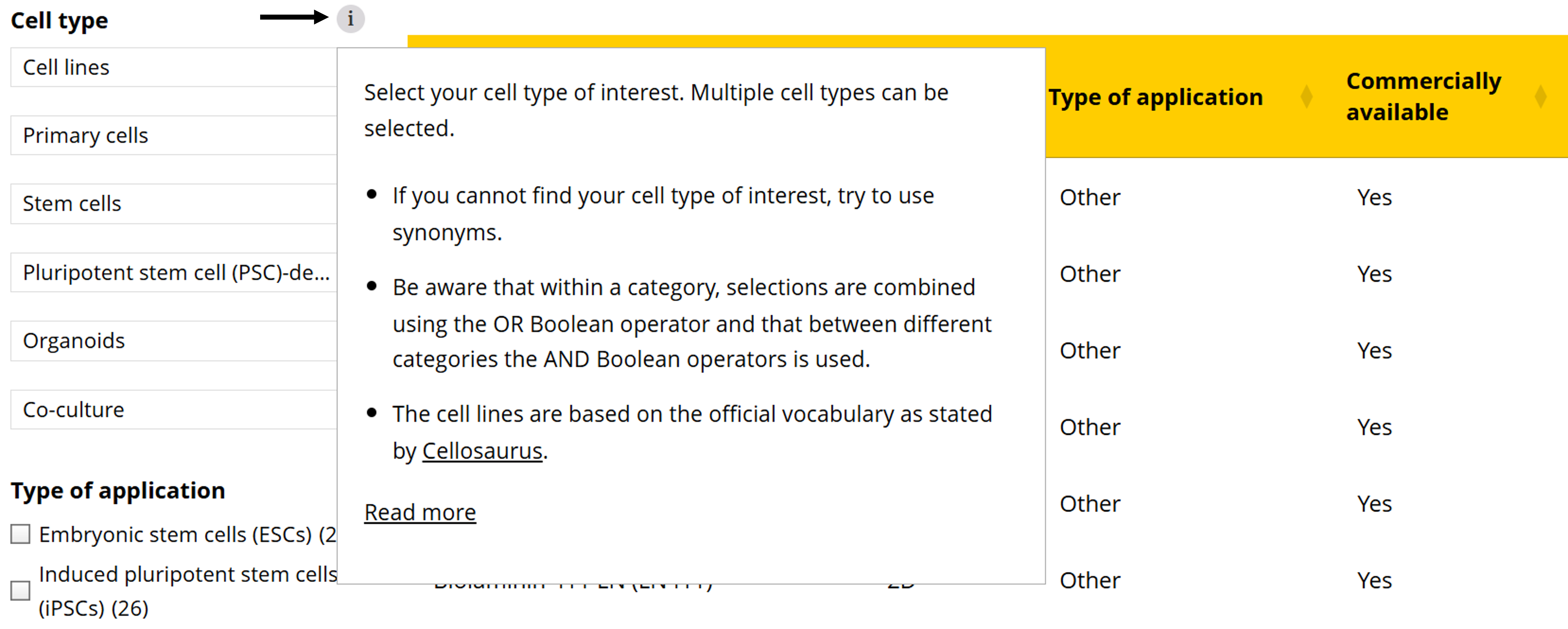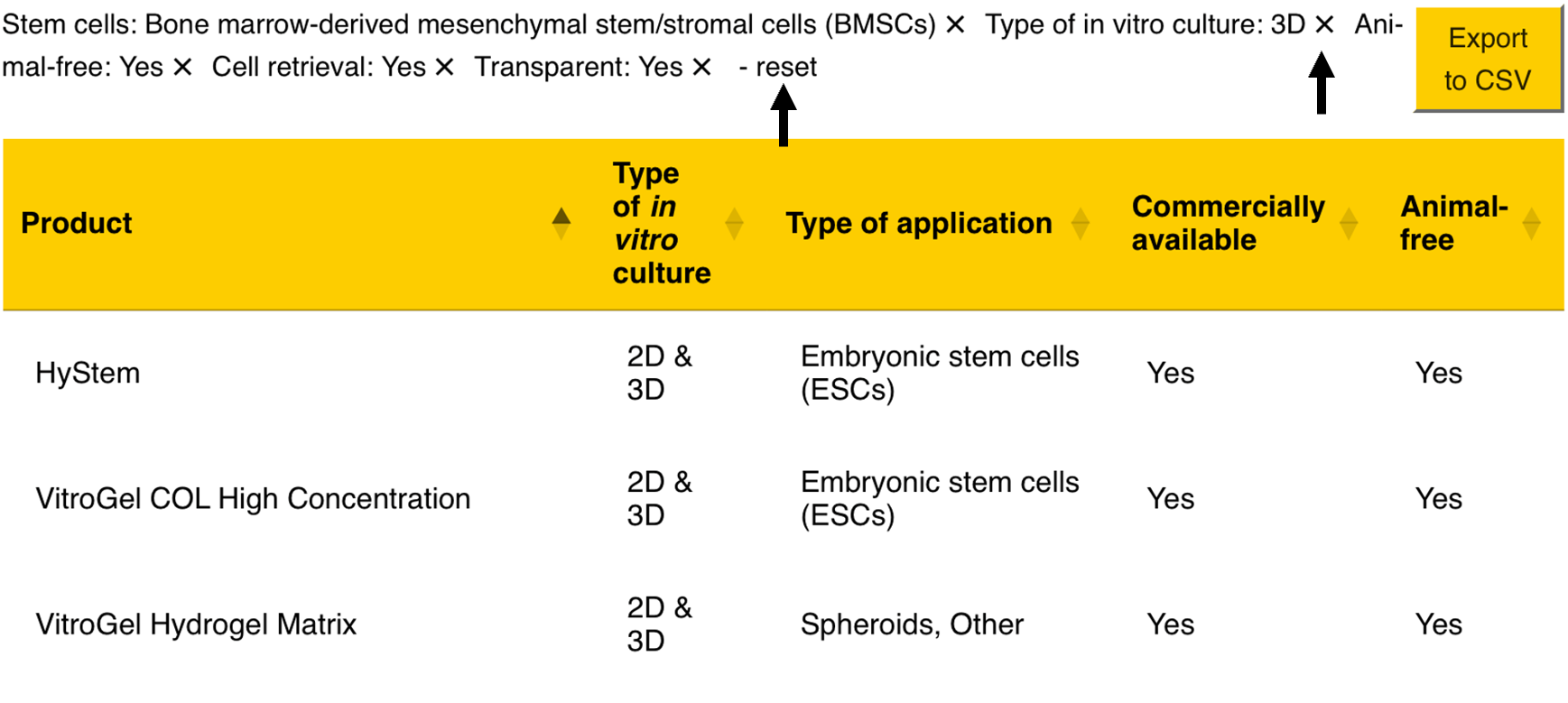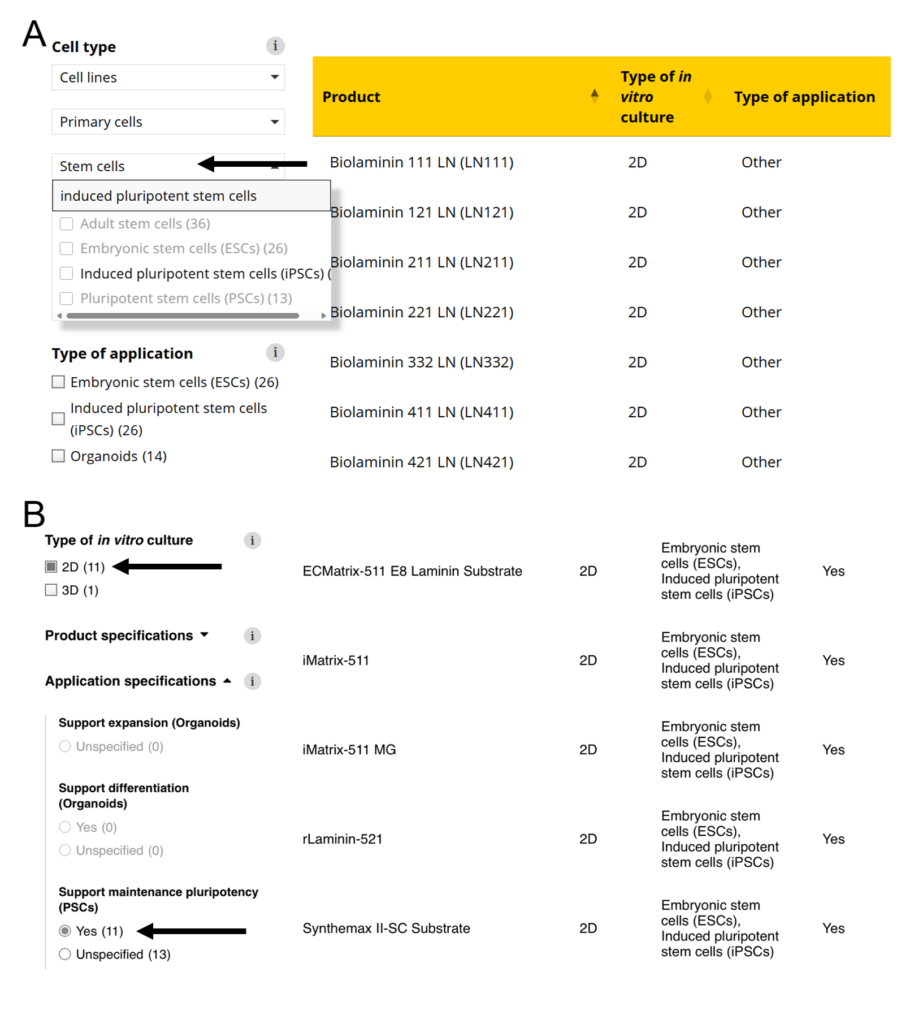The Basement Membrane Extract (BME)-free Database provides an overview of commercially available hydrogel- and coating-based products designed for in vitro applications wherefore BME is commonly used, such as organoids, spheroids, embryonic stem cells (ESCs), induced pluripotent stem cells (iPSCs) and specific in vitro assays (e.g., invasion assays and angiogenesis assays).
As a universal alternative to BME does not exist (yet), the products included in this database are often tailored to specific applications and/or cell types. Users can fine-tune their search by applying filters based on relevant parameters.
Please note, this database does not include alternatives described in scientific literature. Furthermore, the database exclusively includes products that are hydrogel- and coating-based. Other product types, such as bioreactors and cell culture plastics, are not included.
How to perform a search?
When no filter has been selected yet, a screen with a selection of default results is shown. The search query can be fine-tuned by using the available filter options, resulting in a selection of products that comply with the query. After selecting a filter, the other available filters will be adjusted. The selected search query is displayed above the product table.
To start a search, users can either select a “Cell type” when looking for specific cells or choose a “Type of application” when searching for a more general application. Once a selection is made, users can then choose the “Type of in vitro culture” (2D or 3D). Clicking on “Product specifications” and “Application specifications” will reveal additional filter options that can be further selected. At last, “Keywords” can be selected. Multiple options can be chosen at the time for each filter to refine the search results. An i-icon is available for more information about each filter (Fig. 1).

The displayed results can be sorted, on alphabetical order for instance, by clicking on the arrow at the right of the parameter of interest. To export the result of your search query, click on the “Export to CSV” icon at the top right above the results table (Fig. 2).

To clear the whole search query, click on the “Reset” icon. To remove a specific parameter from the search query, click on the “X” (cross) icon next to the specific parameter (Fig. 3).

Step-by-step example
A researcher is looking for an alternative coating to BME for the culturing of iPSCs. Firstly, iPSCs need to be selected (Fig. 4A). This can be either done by selecting iPSCs under “Cell type” (Cell type – Stem cells: Induced Pluripotent Stem Cells (iPSCs)) or “Type of application” (Type of application: Induced Pluripotent Stem Cells (iPSCs)). Secondly, select “Type of in vitro culture: 2D” for coatings (Fig. 4B). Thirdly, as it is important that iPSCs maintain their pluripotency and do not undergo spontaneous differentiation when cultured on the product, it is possible to select under “Application specifications” the filter “Support maintenance pluripotency (PSCs): Yes”. The products that match all selected criteria are displayed in the table. When clicking on a product name in the table, a new page will appear with detailed information of the product.

Or watch the demo video below:
Filter definitions
Cell type
The cell type filter allows users to select their cell type(s) of interest. This filter is divided into six distinct categories. Users can type in the search field their cell type of interest and subsequently select the cell type. Users can select multiple cell types within, and, across these categories. Multiple selections within the same category are combined using the OR Boolean operator, meaning results will match any of the selected criteria. Selections across different categories are combined using the AND Boolean operator, meaning that the results must meet all selected criteria.
If there is no hit when typing in a specific cell type, this either means that the cell type is not listed in the database or that a synonym should be used.
See below for the list of available categories:
Cell lines
The cell line category is based on the official cell line vocabulary and RRID number as stated by Cellosaurus. Note that the ESC and iPSC cell lines are listed under “ESCs” and “iPSCs” in the “Stem cells” category, respectively.
Primary cells
The cell types in this category are categorised per tissue type. It is also possible to select all cell types of a specific tissue, by clicking on the tissue itself. Each tissue can also have a “Tumour” category, listing the tissue-specific tumour cells. “Unspecified” means that the (tumour) tissues, as stated by the companies, are not traceable to a specific cell type. Please note that (tissue-specific) adult stem cells and pluripotent stem cell (PSC)-derived cells are listed under the “Stem cells” and “Pluripotent stem cell (PSC)-derived cells” category, respectively.
Stem cells
The stem cells category is divided in the following subcategories: adult stem cells, ESCs, iPSCs and PSCs. The adult stem cells category lists all the (tissue-specific) multipotent stem cells. When products are generally applicable for ESC or iPSC cultures, the product is listed as “ESCs: General” or “iPSCs: General”, respectively. Specific ESC and iPSC cell lines are listed under their respective subcategory using the official vocabulary and RRID number as stated by Cellosaurus.
Pluripotent stem cell (PSC)-derived cells
This category contains the following subcategories: ESC-, iPSC- and PSC-derived cells. These subcategories contain all the differentiated cell types derived from ESCs, iPSCs and PSCs, respectively. In these categories, there is no further subcategorization based on tissue type.
Organoids
The organoids category is subdivided based on whether the organoids are derived from iPSCs, patient-derived xenografts (PDXs) or tissues (e.g., biopsy). The tissue category also includes organoid types of which the origin is unspecified.
Co-culture
In this category all available co-cultures are listed. The co-cultures can be of various combinations, such as two cell lines, but also a stem cell and a primary cell.
Type of application
The application filter allows users to select for a specific application of interest: ESCs, iPSCs, spheroids and/or organoids. “Other” is an overarching option for products suited for applications not listed above. This category contains specific in vitro assay applications for instance, which are listed under the filter “Keywords”. Multiple options can be selected, which are combined using the AND Boolean operator.
Type of in vitro culture
This filter allows users to specify whether the product should be applicable for culturing cells on a coated surface or on top of a hydrogel (2D) and/or for culturing cells encapsulated in a hydrogel (3D). Both options can be selected, which are combined using the AND Boolean operator.
Product specifications
This set of filters allows users to specify various product characteristics such as:
Commercially available
This filter indicates whether a product is commercially available (Yes) or not (No).
Animal-free
This filter indicates whether the product is entirely free of animal-derived components (Yes) or whether to product contains animal-derived components (No). It is essential to note that human-derived components, such as human platelet lysates, are considered as “Animal free: Yes” in the database. Products that lack a detailed description about their origin are defined as “Animal free: Unspecified”.
Chemically defined
This filter indicates whether the material of the product is chemically defined (Yes) or not (No) based on the information provided by the company. Products based on lysates and extracts are classified as “Chemically defined: No”. Products that lack an extensive description on their composition or do not mention (chemically) defined are classified as “Chemically defined: Unspecified”.
Mechanical properties
This filter indicates whether the mechanical properties of a product are specified or unspecified.
Possibility to conjugate biomolecules
This filter indicates whether it is possible to (non)covalently conjugate biomolecules (e.g., proteins or peptides) to the main material of the product (Yes). Products that do not describe the possibility of conjugating biomolecules are classified as “Unspecified”. Products that clearly describe that conjugating biomolecules is not possible are classified as ”No”.
Coating-based products derived from recombinant proteins are considered as “Possibility to conjugate biomolecules: No”, unless otherwise specified. Please keep in mind that recombinant proteins (e.g., laminins) can be used to (bio)functionalise other products with to improve cellular functionality (e.g., cell adhesion, survival/proliferation, migration, differentiation and/or other cell type-specific responses).
Application specifications
This set of filters allows users to further refine application characteristics such as:
Support expansion (Organoids)
This filter is solely applicable for products that are assigned to “Type of application: Organoids”. This filter indicates whether organoids can be expanded with a minimum of three passages (Yes), whether expansion is not possible of limited to maximal two passages (No) or when information regarding expansion is not clearly stated (Unspecified).
Support differentiation (Organoids)
This filter is only applicable for products that are assigned to “Type of application: Organoids”. This filter indicates whether organoids can be successfully differentiated upon initiating differentiation (e.g., via the use of differentiation medium) (Yes), whether differentiation is not possible (No) or whether the effect on differentiation is not clearly specified (Unspecified).
Support maintenance pluripotency (PSCs)
This filter is solely applicable for products suitable for PSC applications (“Type of application: ESCs or iPSCs”). This filter indicates whether pluripotency of PSCs can be maintained (Yes), whether PSCs undergo spontaneous differentiation (No) or when it is not clearly specified (Unspecified).
Cell retrieval
This filter is only applicable for 3D cell culture products (“Type of in vitro culture: 3D”). This filter indicates whether it is possible to retrieve cells from the product for subsequent passaging and/or downstream analyses (Yes). In case it is clearly specified that cell retrieval is not possible, the product is classified as “No”. In case it is not clearly specified whether cell retrieval is possible, the product is classified as “Unspecified”.
Dome formation
This filter is only applicable for products with organoids and/or spheroid applications (“Type of application: Organoids and/or Spheroids”). It defines whether it possible to culture spheroids/organoids in a dome or droplet of the product (Yes) or whether it is not clearly specified (Unspecified). In case the product does not allow dome formation or when it is not recommended by the company, it is classified as “Dome formation: No”.
Autofluorescent
This filter indicates whether the product is autofluorescent (Yes) or not (No) or when it is not clearly specified by the company (Unspecified).
Transparent
This filter indicates whether the product is transparent (Yes) or not (No) or when it is not clearly specified by the company (Unspecified).
Keywords
The keywords filter can be used to select predefined keywords. These keywords are based on specific in vitro application types (e.g., angiogenesis assays, invasion assays, migration assays and organ-on-a-chip models) or specific proteins/peptides which have been supplemented/conjugated to a product. For example, products conjugated with laminin-derived peptides, such as IKVAV or YIGSR, have the keyword “Laminin” and products with a RGD motif or matrix metalloproteinases (MMP)-sensitive peptides belong to the keywords ”RGD” and “MMP”, respectively. Multiple keywords can be selected, which are combined using the OR Boolean operator.
Product information
When clicking on the product name in the table, a new page will appear with detailed information of the selected product. The information does not only contain (further) details regarding the parameters, but it also provides more specific information about the type of product and links to the product page and instructions.
Please note, the products have not been validated by the 3Rs Centre Utrecht. Therefore, we cannot verify whether all listed cell types can be successfully cultured when using the product. Users are encouraged to perform their own research to gather additional information where necessary.
Commercial source
Name of the company
URL
Link(s) to the product webpage(s)
Product details
Origin
Whether the material of the product is of natural or synthetic origin.
Type of material
Detailed information about the (main) material of the product. In case the material is supplemented/conjugated with specific proteins/peptides, these are listed under “Keywords”.
Type of gelation/Coating
The type of gelation is specified for hydrogel-based products. For coating-based products “Coating” is mentioned.
Type of in vitro culture
The type of in vitro culture the product can been used for: culturing cells on a coated surface or on top of a hydrogel (2D) and/or for culturing cells encapsulated in a hydrogel (3D).
Type of application
The type of applications the product can be used for.
Cell type
For more information see section “Cell type”. “Unspecified” means that the product has not been assessed on specific cell types based on the information provided by the source.
Product specifications
For more information, see section “Product specifications“.
Commercially available
Whether the product is commercially available or not.
Animal-free
Whether the product is animal-free, not animal-free, or if it is “Unspecified”.
Chemically defined
Whether the product is chemically defined, not chemically defined, or if it is “Unspecified”.
Mechanical properties
Whether the mechanical properties of the product are specified or not. In case the mechanical properties are specified, the value is stated.
Possibility to conjugate biomolecules
Whether it is possible to (non)covalently conjugate biomolecules to the product. In case the product is categorised as “Possibility to conjugate biomolecules: Yes”, the conjugation method is specified. The conjugation method is “Unspecified” when further details regarding the method have not been provided by the source.
Application specifications
For more information, see section “Application specifications“.
Support expansion (Organoids)
Whether the product supports expansion of organoids. In case “Support expansion (Organoids): Yes”, the number of passages is specified.
Support differentiation (Organoids)
Whether the product supports the differentiation of organoids.
Support maintenance pluripotency (PSCs)
Whether the product supports maintenance pluripotency of PSCs.
Cell retrieval
Specifications whether cells can be retrieved from the product. In case “Cell retrieval: Yes”, details regarding the retrieval method are provided including whether the method is enzymatic or enzyme-free.
Dome formation
Specifications whether the product supports dome formation. This filter is only applicable for products with “Type of application: Organoid and/or Spheroids”.
Imaging
Specifications about the autofluorescence and transparency of a product.
Instructions
Links to the product instructions and/or to the protocols describing downstream analyses.
Keywords
Mentioning of keywords based on specific in vitro applications or specific proteins/peptides which have been supplemented/conjugated to a product.
Products conjugated with laminin-derived peptides, such as IKVAV or YIGSR, have the keyword “Laminin”. GFOGER-conjugated products have the keyword “Collagen”. Products with a RGD motif or MMP-sensitive peptides belong to the keywords ”RGD” and “MMP”, respectively.

